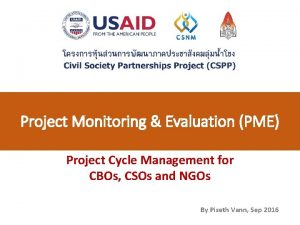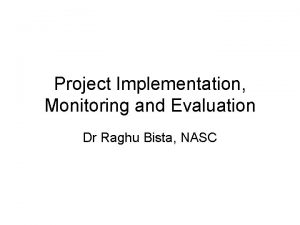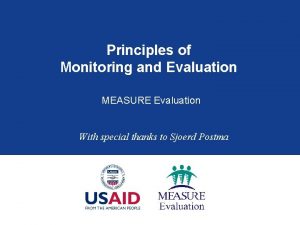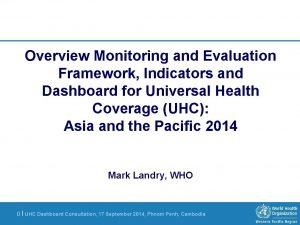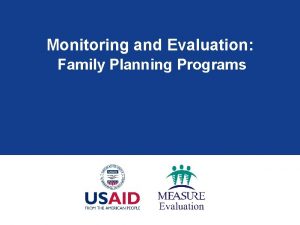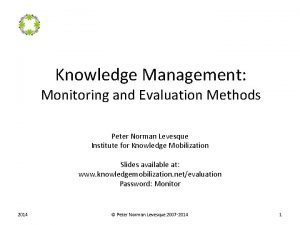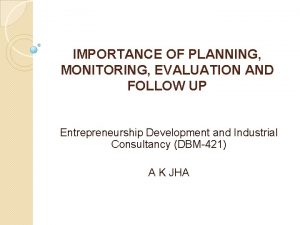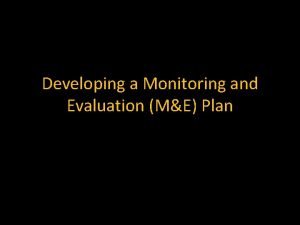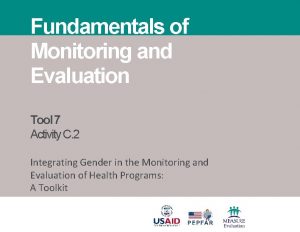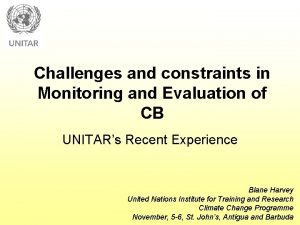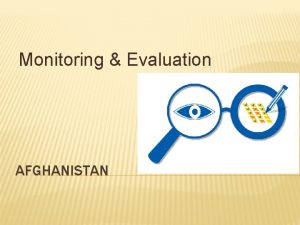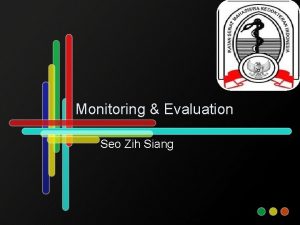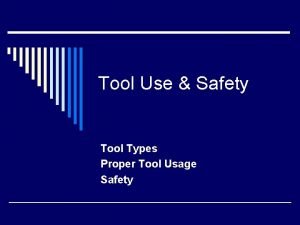Fundamentals of Monitoring and Evaluation Tool 7 Activity















- Slides: 15

Fundamentals of Monitoring and Evaluation Tool 7 Activity C. 2 Integrating Gender in the Monitoring and Evaluation of Health Programs: A Toolkit

Learning Objectives • Define monitoring and evaluation (M&E) • Review the purpose of M&E • Explore how M&E fits in the program life cycle • Describe the components of M&E plans

Activity Brainstorming • • What is monitoring? What is evaluation? How are they different? How do they fit together?

Key Points Monitoring Evaluation • Ongoing • Is not continuous • Continuous process • Data collection at the start and end of a program • Data collection at multiple points throughout a program • Tracking changes over time • Control/comparison group • Well-planned study design

Definition Monitoring Performance monitoring reveals whether desired results are occurring and whether implementation is on track. In general, the results measured are the direct and near-term consequences of project activities. • Performance monitoring is used to gauge whether activities need adjustment in the course of the intervention to improve the use of resources and the achievement of desired outcomes. • It requires the collection of data at multiple points throughout the program cycle, including at the beginning to provide a baseline.

Definition Evaluation is the systematic collection and analysis of information about the characteristics and outcomes of a program or project as a basis for judgments, to improve effectiveness, and/or to inform decisions about current and future programming. Evaluation is distinct from assessment, which may be designed to examine country or sector context to inform project design or an informal review of a project.

Types of Evaluations Performance evaluation focuses on descriptive and normative questions: what has a particular project or program achieved; how it is being implemented; how is it perceived and valued; are expected results occurring; and other questions that are pertinent to program design, management, and operational decision making. • Performance evaluations often incorporate before-after comparisons, but generally lack a rigorously defined counterfactual. • They involve the collection of data at the start of a program (to provide a baseline) and again at the end.

Types of Evaluations Impact evaluation measures the change in a development outcome that is attributable to a defined intervention; impact evaluations are based on models of cause and effect and require a credible and rigorously defined counterfactual to control for factors other than the intervention that might account for the observed change. • Impact evaluations in which comparisons are made between beneficiaries that are randomly assigned to either a treatment or a control group provide the strongest evidence of a relationship between the intervention under study and the outcomes measured.

Why is M&E Important? • M&E provide objective evidence to inform decision making. • M&E ensure the most effective and efficient use of resources. • M&E objectively assess the extent to which a program is having or has had the desired impact, in what areas it is effective, and where corrections need to be considered. • M&E produce information that can help convince donors that their investments have been worthwhile or that alternative approaches should be considered.

When should M&E take place? • M&E are continuous processes that occur throughout the life of a program. • To be most effective, M&E should be planned at the design stage. • Monitoring should be conducted at every stage of the program, with data collected, analyzed, and used on a continuous basis. • Evaluations are usually conducted at the end of programs. However, they should be planned at the start because baseline data are important for end-of-program comparisons.

What is an M&E Plan? An M&E plan is a fundamental document that describes: • A program’s objectives. • The interventions developed to achieve these objectives. • The activities that will determine whether or not the objectives are met. • How the expected results of a program relate to its goals and objectives. • The data needed and how the data will be collected, analyzed, and used. • The resources required to conduct the plan. • How the program will be accountable to stakeholders.

What makes an M&E Plan? M&E plans can be organized in a variety of ways. The plan typically includes: • Underlying assumptions • Anticipated relationships • Measures and definitions • Monitoring schedule • Data sources • Cost estimates • List of partnerships and collaborations • A plan for dissemination and use of information gained

Monitoring & Evaluation References & Resources • Gage, A. J. , & Dunn, M. (2010). Module II: Monitoring and evaluating genderbased violence prevention and mitigation programs: a facilitator’s training guide. Chapel Hill, NC, USA: MEASURE Evaluation, University of North Carolina. Retrieved from https: //www. measureevaluation. org/resources/training/capacity-buildingresources/gbv. • Frankel, N. , & Gage, A. (2007, rev. 2016). M&E fundamentals: a self-guided minicourse MS-07 -20_rev 2016. pdf). Chapel Hill, NC, USA: MEASURE Evaluation, University of North Carolina. Retrieved from http: //www. cpc. unc. edu/measure/publications/ms-07 -20. • Frankel, N. , & Gage, A. (2006). Global Health e. Learning Center course on M&E fundamentals. Retrieved from http: //www. globalhealthlearning. org/course/m-e-fundamentals.

Monitoring & Evaluation References & Resources • Social Impact, Inc. (2013). Performance management plan (PMP) toolkit. A guide for Missions on planning for, developing, updating, and actively using a PMP. Washington, DC, USA: Social Impact, Inc. Retrieved from http: //usaidprojectstarter. org/sites/default/files/resources/pdfs/PMP-Toolkit. pdf. • Measurement, Learning & Evaluation Project. (2013). Measuring success toolkit: sample outline of an M&E plan. Retrieved from https: //www. urbanreproductivehealth. org/toolkits/measuring-success/sampleoutline-me-plan. • USAID. (2016). USAID evaluation policy. Washington, DC, USA: USAID. Retrieved from https: //www. usaid. gov/sites/default/files/documents/1870/USAIDEvaluation. Poli cy. pdf.

This presentation was produced with the support of the United States Agency for International Development (USAID) under the terms of MEASURE Evaluation cooperative agreement AID-OAA-L-14 -00004. MEASURE Evaluation is implemented by the Carolina Population Center, University of North Carolina at Chapel Hill in partnership with ICF International; John Snow, Inc. ; Management Sciences for Health; Palladium; and Tulane University. Views expressed are not necessarily those of USAID or the United States government. www. measureevaluation. org
 Monitoring and evaluation tool sample deped
Monitoring and evaluation tool sample deped Swot analysis in school improvement plan
Swot analysis in school improvement plan Pregnancy and infant cohort monitoring and evaluation
Pregnancy and infant cohort monitoring and evaluation Activity and exercise fundamentals of nursing
Activity and exercise fundamentals of nursing Monitoring cycle in project management
Monitoring cycle in project management Comparison between monitoring and evaluation
Comparison between monitoring and evaluation 7 principles of monitoring and evaluation
7 principles of monitoring and evaluation M&e dashboard
M&e dashboard Monitoring and evaluation of family planning programs
Monitoring and evaluation of family planning programs Knowledge management monitoring and evaluation
Knowledge management monitoring and evaluation Importance of planning, monitoring and evaluation
Importance of planning, monitoring and evaluation Monitoring plan sample
Monitoring plan sample Principles of monitoring and evaluation
Principles of monitoring and evaluation Basics of monitoring and evaluation
Basics of monitoring and evaluation Constraints in monitoring and evaluation
Constraints in monitoring and evaluation Centre for evaluation and monitoring
Centre for evaluation and monitoring




